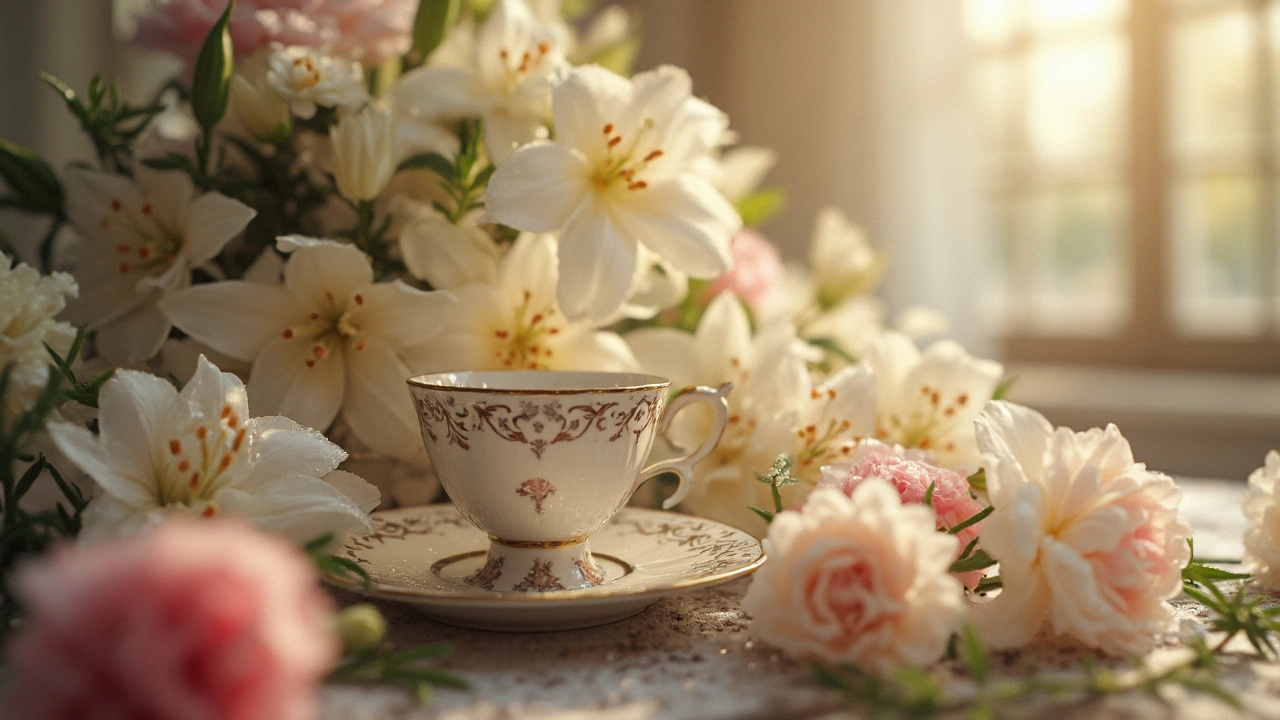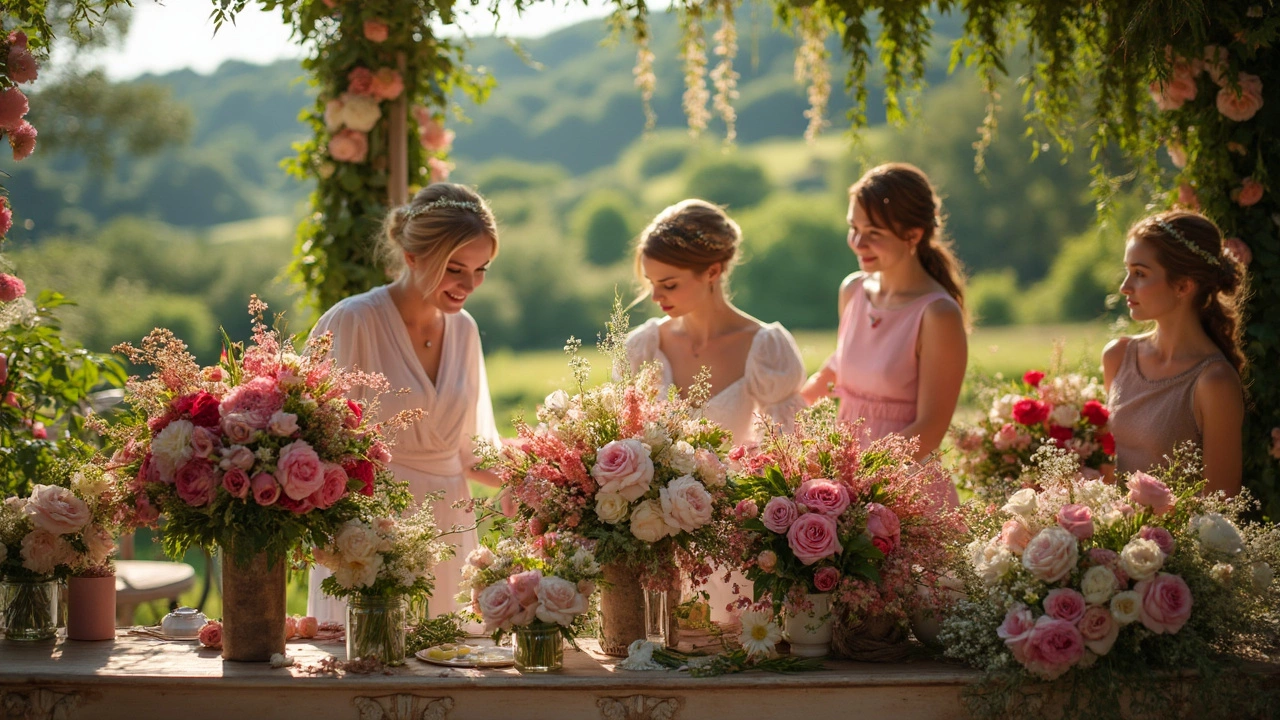Getting the timing right for your wedding flowers can feel like one of those 'impossible to solve' puzzles. But don’t worry, it's all about knowing your flowers and trusting your florist. So, how many days before the wedding should you actually get your flowers? Well, most experts recommend having them arrive 1 to 3 days before the big event.
Why so specific? Wedding flowers are like the Goldilocks of wedding planning: too early, and they might wilt; too late, and you're in panic mode. When it comes to different flower types, roses might last a tad longer than hydrangeas, so it varies. Chatting with your florist about what you have in mind not only helps with timing but can also save you from floral disasters.
Most importantly, ensure you have a cool, dark space to store them until the ceremony. Think of it as giving your flowers a day spa treatment before they strut their stuff. And hey, if things go south, having a backup plan with a local florist can save the day. Stay tuned for some cool alternative options in case you need to pivot last minute.
- Timing the Flower Delivery
- Types of Flowers and Longevity
- Talking to Your Florist
- Storing Your Flowers
- Handling Floral Emergencies
- Alternative Floral Options
Timing the Flower Delivery
When you're planning a wedding, organizing the arrival of your wedding flowers is a bit like juggling; it's all about the timing. So, when exactly should these floral beauties show up? Ideally, you want your flowers delivered to you 1 to 3 days before your ceremony. Why this precise window?
The goal is to keep your flowers looking fresh and vibrant. If they arrive too early, they might start wilting or losing their charm before the big day. On the other hand, scheduling delivery too close to the event can lead to unnecessary stress and panic if anything goes wrong.
Different flowers have different lifespans, and this affects delivery timing. For instance, lilies and roses are generally hardier and can be delivered a bit earlier. Here’s a rule of thumb: discuss your selected flowers' shelf life with your florist when placing your order. They’ll know the best timing based on the season and the types of flowers you've chosen, thereby avoiding any mushy mishaps.
Having a reliable and communicative florist is crucial. Make sure you clearly outline your delivery schedule in your contract. This helps avoid confusion and ensures everything is documented well in advance. Plus, knowing the florist's delivery timeline lets you plan other logistics without a hitch.
Lastly, if you have a lot of floral arrangements or particularly delicate choices, consider discussing a trial run or asking for professional handling upon delivery. This small step can make a big difference.
Types of Flowers and Longevity
Choosing the right flowers for your wedding isn’t just about picking your favorites; it’s also about understanding how long they'll last. Some flowers are known for their durability and are perfect when you need them to stay fresh longer. Take roses, for example. These classic beauties are not only stunning but can also hold their charm for about a week, making them a reliable choice.
Lilies, on the other hand, while equally popular, might not stick around as long. They generally last for 5 to 7 days tops. Then, we have tulips and daffodils. These spring darlings can brighten up your arrangements, but don’t expect them to last more than a handful of days without wilting, especially in warmer venues.
If you're eyeing hydrangeas, just know they look lush but might require extra care to avoid drooping. Florists often suggest keeping them hydrated because they can start looking tired quickly if they dry out.
Here's a quick reference to help you out:
- Roses: Approximately 7 days
- Lilies: 5-7 days
- Tulips: 3-5 days
- Hydrangeas: Up to 5 days with care
- Sunflowers: About 6-8 days
Of course, these are estimates, and factors like storage, temperature, and handling will affect longevity. Make sure to consider these aspects when planning your wedding flowers to ensure that they look their best when you say 'I do'.
Talking to Your Florist
Having a chat with your florist isn’t just about picking out pretty blooms. It’s about making sure your wedding day flowers are exactly as you imagined and that they arrive at just the right time. Think of your florist like a partner in crime for your wedding planning—they know their stuff.
Start by discussing the theme and color palette of your wedding. Let them know about any specific flowers that have sentimental value or ones you're completely in love with. This will help them tailor the arrangements specifically for you.
- Ask them about the availability and seasonality of your chosen flowers—some flowers may be hard to get at your wedding time.
- Discuss delivery options — will they set up at the venue themselves, or will they just deliver?
- Clarify logistics, like storage requirements and timing of delivery. Aim for a delivery 1-3 days before the wedding for optimal freshness.
- Ask about contingency plans. What if something happens and your flowers can't be delivered?
Your florist should also explain how best to store the arrangements once they arrive. Usually, this means keeping them in a cool spot, away from direct sunlight. And don’t forget to get a detailed quote. This way, you can plan your budget without any surprises.
Did you know that a survey found that about 40% of couples wished they had spent more time communicating with their florists? Taking the time for detailed conversations can make all the difference.

Storing Your Flowers
Alright, so you've got your beautiful wedding flowers delivered, and the next step is making sure they stay fresh and picture-perfect for your big day. It’s not just about putting them on the counter and hoping for the best. Proper storage can make all the difference.
First off, find a cool, dark spot. We’re talking about 4°C to 7°C if you can manage it. Room temperature is not your friend here. Your kitchen pantry or a basement might do the trick, just avoid anywhere that messes with the temperature like near windows or heat vents.
Keep them in water with some flower food if provided. Many florists include packets; just make sure you mix it as instructed. This boosts freshness and helps them drink up all the good stuff.
- Trim the stems at a 45-degree angle before placing them in water. This increases surface area for water uptake.
- Remove any leaves that might fall below the waterline. This prevents bacteria growth.
If you've got bouquets, keep them secured with their wrappings until you’re ready to use them. Arrangements for centerpieces can go in your chosen vases, ready to plop on tables.
Need to check on them? Gently touch the petals or foliage—to feel, not to pluck. If they are thirsty, you’ll know because they feel a bit limp.
And here's a fun fact: storing them with fruits like apples or bananas is a no-no. These fruits release ethylene gas, which can accelerate wilting.
| Ideal Storage Temperature | Common Household Place |
|---|---|
| 4°C to 7°C | Basement/Pantry |
Follow these tips, and your floral arrangements should look as vibrant as they did when they walked down the aisle—err, I mean when you unboxed them.
Handling Floral Emergencies
Even with the best planning, sometimes things go sideways, and an unexpected floral disaster might just be lurking around the corner. Whether it's wilting blooms or a delivery mishap, keeping your cool is vital.
If you suddenly find your wedding flowers looking worse for wear, start by identifying the problem. Are they simply thirsty or perhaps suffering from a temperature shock? Ensure they are properly hydrated by trimming the stems and placing them in fresh water. If wilting is the issue, a little spritz of water might help to revive them temporarily.
Now, let's say the delivery is running late, causing panic mode to set in. Here is where having a contingency plan makes all the difference. Have you already contacted a couple of local florists in case of emergencies? Most places will have something ready to go, just in case.
If your floral arrangements are tailored and specific, then consider having some backup options, like neutral-colored bouquets that fit any theme. They might not be exactly what you envisioned, but they'll still look stunning in photos.
Check out this quick backup checklist to keep handy in emergency situations:
- Contact the original florist to confirm the status and any alternate solutions.
- Call local florists for readily available floral arrangements.
- Get creative—think about substituting with non-floral centerpieces in the worst-case scenario.
To wrap it up, think of your wedding planning as having a built-in safety net. A little foresight and a backup strategy can keep you smiling, even if things don't go quite as planned.
Alternative Floral Options
Sometimes, things don't go as planned with your wedding flowers. Maybe the delivery is late, or the bouquets don't look quite right. That's when you can consider some alternative floral options, which can save your big day.
Have you considered the beauty and practicality of silk or paper flowers? They can be a fantastic substitute that's not only long-lasting but also looks stunning in photos. Plus, they come in every color under the sun, so matching them to your theme is a breeze!
If you’re looking for a more sustainable option, potted plants are a lovely alternative. Think small succulents as table centerpieces or even larger potted arrangements lining the aisle. Not only do they add a fresh touch, but guests can take them home as keepsakes.
- Silk Flowers: Lifespan can extend to years, and they don’t wilt, ensuring your bouquet stays as beautiful as when you first saw it.
- Paper Flowers: Affordable and customizable, they can be a creative and personalized touch to your wedding.
- Potted Plants: They double as décor and gifts, perfect for an eco-friendly couple.
For those counting nickels and dimes, buying fresh flowers from a local market and arranging them yourself is another avenue. It could make for a fun pre-wedding activity with your closest friends.
Additionally, if you have floral allergies or want to minimize your carbon footprint, less conventional materials like feathers or dried flower arrangements could be an ideal pick. These options can add unique textures and a bit of whimsy to your ceremony.
Remember, variety is the spice of life. If traditional blossoms aren't in the cards, there are plenty of alternatives out there that can make your special day bloom just the way you imagined.
